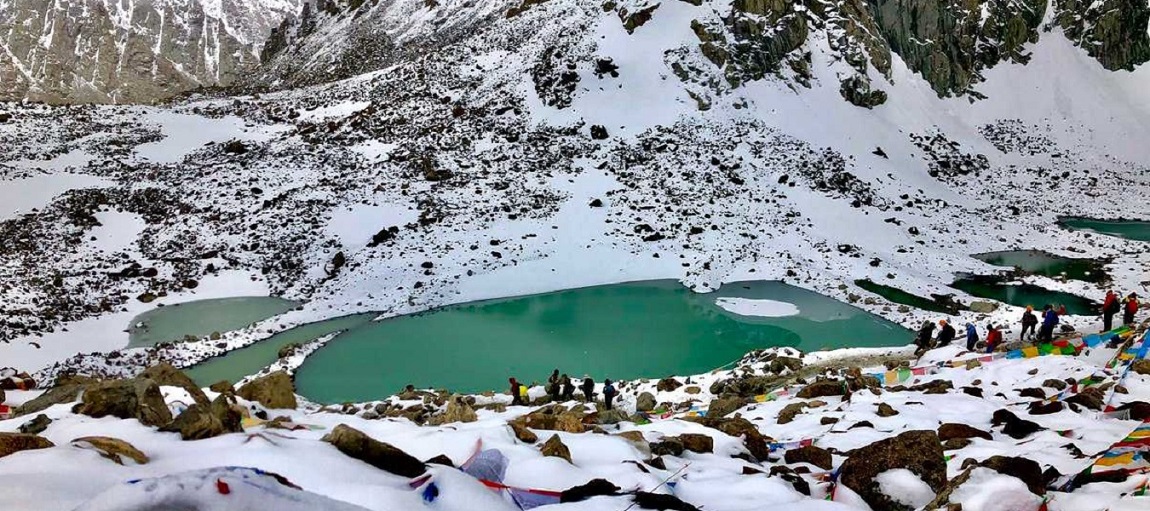Kedarnath is a town located in the Indian state of Uttarakhand, renowned for its significant religious and historical importance. It is situated in the Himalayas at an altitude of about 3,583 meters near the Chorabari Glacier, the source of the Mandakini River. The town is home to the Kedarnath Temple, one of the most revered Hindu shrines dedicated to Lord Shiva. It is one of the twelve Jyotirlingas and is a part of the Char Dham Yatra which includes Yamunotri, Gangotri, Kedarnath and Badrinath. According to legend, the temple was built by the Pandavas from the Mahabharata to atone for their sins after the Kurukshetra war. The current structure is believed to have been established by Adi Shankaracharya in the 8th century AD. The pilgrimage to Kedarnath is undertaken by thousands of devotees each year. The trek from Gaurikund, the nearest road head to Kedarnath is approximately 16 kilometers and is quite challenging due to the high altitude and rugged terrain. Kedarnath not only holds religious importance but also serves as a cultural hub where traditional Hindu rituals and practices are observed. The annual festival of Badri-Kedar Utsav is celebrated with great fervor, attracting pilgrims and tourists alike.
The region around Kedarnath offers a variety of scenic, spiritual and adventurous destinations that are popular among pilgrims and tourists. Here are some of the most popular places to visit near Kedarnath:
Gaurikund: Gaurikund is a significant pilgrimage site and a major point of interest for visitors heading to Kedarnath. It is approximately 16 Kilometres from Kedarnath. Gaurikund is named after Goddess Parvati (also known as Gauri). According to Hindu mythology, it is believed to be the place where Goddess Parvati meditated and performed severe penance to win Lord Shiva's affection. The site is thus considered sacred, and devotees often visit it to seek blessings and pay homage. It is starting point for Kedarnath Trek. Gaurikund serves as the base camp for the trek to Kedarnath Temple. Pilgrims and trekkers start their journey from here to cover the 16-kilometer trek to the temple. Gauri Temple- A small but significant temple dedicated to Goddess Parvati. Devotees visit this temple to seek blessings before starting their trek to Kedarnath. Hot Springs - Gaurikund is renowned for its natural hot springs. Pilgrims take a dip in these thermal springs, believing it to be a purifying ritual before embarking on the arduous trek to Kedarnath. The water is considered to have medicinal properties that can help relieve stress and fatigue.
Kalimath: Kalimath is a revered pilgrimage site located in the Rudraprayag district of Uttarakhand, India. It holds significant religious importance particularly in Hinduism and is known for its temple dedicated to the goddess Kali. Kalimath is considered one of the Siddha Peeths, places where divine energy is believed to manifest. It is particularly significant for worshippers of Goddess Kali. According to mythology after slaying the demon Raktabeej, the goddess went underground at this location, making it a sacred spot. The area is also associated with the goddesses Laxmi and Saraswati who are believed to have worshipped here. The primary attraction is the Kalimath Temple dedicated to Goddess Kali. Unlike typical temples, the idol of Kali is not worshipped in the form of a statue but through a sacred Shakti Yantra placed on a pedestal. The temple is unique as it does not have a statue of the goddess inside, following a tradition where only a Shri Yantra is worshipped. Special pujas and rituals are conducted during Navratri, a nine-night festival dedicated to the goddess. The temple attracts a large number of devotees during this period.
Vasuki Tal: Vasuki Tal is a high-altitude glacial lake located in the Indian state of Uttarakhand. It is renowned for its serene beauty and the challenging trek required to reach it making it a popular destination for adventure enthusiasts and trekkers. According to Hindu mythology, Vasuki Tal is named after the serpent Vasuki who is associated with Lord Shiva. It is believed that Lord Vishnu bathed in this lake during the Rakshabandhan festival. Although not as frequented as Kedarnath, Vasuki Tal holds spiritual significance for devotees who undertake the trek to seek blessings and witness its pristine beauty. The lake is surrounded by snow-covered mountains and offers breathtaking views of the Chaukhamba peaks and other Himalayan ranges. The clear blue waters of the lake reflect the surrounding peaks, creating a stunning visual. The region around Vasuki Tal is rich in diverse flora and fauna. Trekkers might encounter various alpine flowers, rare herbs and occasional sightings of wildlife such as the Himalayan monal and snow leopard.
Char Dham Yatra is usually undertaken during the summer months typically from May to June or September to October. Start planning your trip well in advance especially if you're traveling during peak season to secure accommodation. Hotels booking for the Chardham Yatra which includes Kedarnath, Badrinath, Gangotri and Yamunotri, requires careful planning especially during the peak pilgrimage season.


